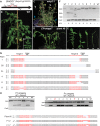Efficient gene editing in tomato in the first generation using the clustered regularly interspaced short palindromic repeats/CRISPR-associated9 system
- PMID: 25225186
- PMCID: PMC4226363
- DOI: 10.1104/pp.114.247577
Efficient gene editing in tomato in the first generation using the clustered regularly interspaced short palindromic repeats/CRISPR-associated9 system
Abstract
The CRISPR/Cas9 system is highly efficient at generating targeted mutations in stable transgenic tomato plants, and homozygous deletions of a desired size can be created in the first generation.
Figures


References
Publication types
MeSH terms
LinkOut - more resources
Full Text Sources
Other Literature Sources
Research Materials

